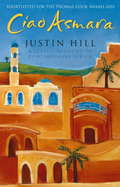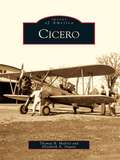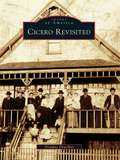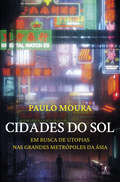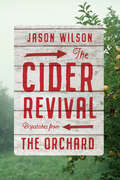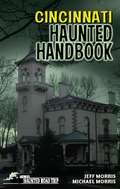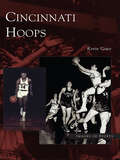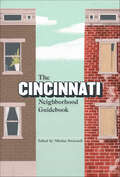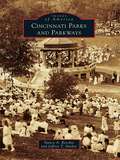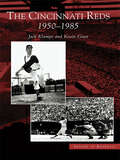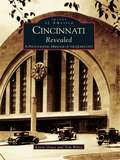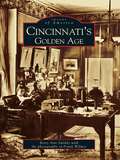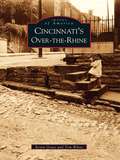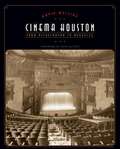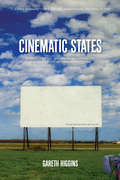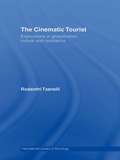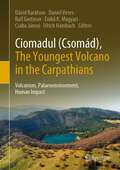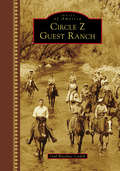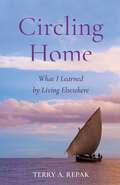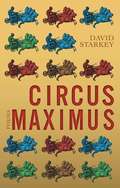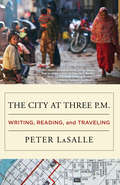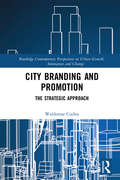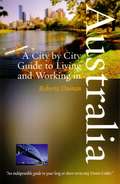- Table View
- List View
Ciao Asmara
by Justin HillAsmara is the capital of Eritrea - a surreally Italian city at the centre of an ex-Italian colony that has been at war with its neighbour Ethiopia (who claim sovereignty over Eritrea) for over ten years. Amidst broken palaces (built by the late Ethiopian emperor Haile Selassie), nomadic desert encampments and war-torn towns, Hill found a god-fearing people remarkably resistant to everything fate has thrown at them. This book is a tribute to their resilience and will stand beside Philip Gouravitch's Rwandan book, WE WISH TO INFORM YOU THAT TOMORROW YOU WILL BE KILLED WITH YOUR FAMILIES, as a classic account of contemporary Africa.
Cicero
by Thomas B. Mafrici Elizabeth A. AugustOne of the fastest-growing suburbs of Syracuse, Cicero lies on the shores of Oneida Lake, the largest lake entirely enclosed within New York. The Cicero area was home to the Iroquois and Owasco Indian tribes. The trails they created through Cicero were transformed into the first plank road laid in the United States. Known as the crossroads of New York, Cicero's central position in the state was crucial in the distribution of agricultural resources from the north to markets throughout New York by way of the Erie Canal, located 10 miles south of Cicero. Cicero was also the home of suffragist and abolitionist Matilda Joslyn Gage, who worked with Elizabeth Cady Stanton and Susan B. Anthony, two leaders in the suffrage movement. From the first plank road through the modern interstate highway system, transportation has always played an important role in the development of this community. Cicero provides a snapshot of the daily life and important events in this town's colorful and dynamic history.
Cicero Revisited
by Douglas DeuchlerStrategically located seven miles west of Chicago's Loop, multifaceted Cicero is one of the oldest and largest municipalities in Illinois. In the late 19th century, this unique industrial suburb developed as an ethnic patchwork of self-sufficient immigrant neighborhoods. Since the Roaring Twenties, when mobster kingpin Al Capone set up shop there, the town has often been characterized by corruption and controversy. Yet the Cicero story continues to be full of promise and adventure, vision and accomplishment. As its population has shifted from heavily eastern European to predominantly Hispanic, Cicero remains a vibrant community where residents maintain strong civic pride, work ethic, and family values.
Cidades do Sol: À procura de utopias nas grandes metrópoles da Ásia
by Paulo MouraCom que sonham os habitantes do futuro. Paulo Moura viaja pelas megacidades da Ásia Oriental em busca da utopia. Uma reflexão eloquente sobre o mundo contemporâneo. «A viagem é um lugar de reflexão, mas também o lugar de todas as ilusões. Esta - a viagem de um português pela Ásia em busca de utopias - é decerto muito antiga.» A influencer que criou uma cidade imaginária em Jacarta. O escritor de ficção científica da Silicon Valley do Oriente. O nonagenário filipino, nomeado para o Nobel da Literatura, que está a escrever um romance sobre Inteligência Artificial. O outro escritor, em Hong Kong, que imaginou fazer upload da consciência humana para um computador. O casal chinês autor de um livro proibido que vendeu 7 milhões em fotocópias. O homem que liderou a revolta da China rural. O fotógrafo que forçou o governo vietnamita a aprovar a lei sobre o casamento gay. A rainha da Internet em Manila. O filósofo de Java com uma teoria global. O famoso rapper indiano que fez carreira apelando à submissão dos jovens… Quem mais nos arriscamos a encontrar numa aventura pelos grandes espaços urbanos da Ásia contemporânea? Não é preciso muito para entrar na alma de Bangalore, Jacarta, Saigão, Manila, Seul, Hong Kong, Macau, Shenzen, Xangai, Pequim, Linquan ou Chongqin: uma mala pequena, duas mudas de roupa, um par de sapatos, uma escova de dentes, caneta e bloco de notas, telemóvel, portátil, passaporte e um pretexto para a viagem: procurar utopias nas cidades do futuro.
The Cider Revival: Dispatches from the Orchard
by Jason Wilson“From unraveling the history of the apple to exploring the intricacies of flavor, [Wilson] reveals the love and labor that goes into a timeless beverage.” —Bianca Bosker, New York Times–bestselling author of Cork DorkCider is the quintessential American beverage. Drank by early settlers and founding fathers, it was ubiquitous and pervasive, but following Prohibition when orchards were destroyed and neglected, cider all but disappeared. In The Cider Revival, Jason Wilson chronicles what is happening now, an extraordinary rebirth that is less than a decade old.Following the seasons through the autumn harvest, winter fermentation, spring bottling, and summer festival and orchard work, Wilson travels around New York and New England, with forays to the Midwest, the West Coast, and Europe. He meets the new heroes of cider: orchardists who are rediscovering long lost apple varieties, cider makers who have the attention to craftsmanship of natural wine makers, and beverage professionals who see cider as poised to explode in popularity. What emerges is a deeply rewarding story, an exploration of cider’s identity and future, and its cultural and environmental significance. A blend of history and travelogue, The Cider Revival is a toast to a complex drink. “Cider is America’s great forgotten beverage. Jason Wilson’s lively, anecdote-filled, passionate paean to what he says should properly be considered ‘apple win’ will go a long way toward giving this immensely varied and complex libation the recognition and appreciation it deserves.” —Colman Andrews, cofounder of Saveur and author of The British Table
Cincinnati Haunted Handbook
by Michael Morris Jeff MorrisThe first book in the new Haunted Handbook line within the popular America's Haunted Road Trip series, Cincinnati Haunted Handbook offers a plethora of eerie spots in the Queen City. Each of the places in Cincinnati Haunted Handbook is presented in a two-page spread that includes directions, a brief history, details about the paranormal activity, and advice on seeing it in person. Sites are organized into sections, including schoolhouses, roads and bridges, hotels and inns, and others. From the winding curves of the spooky Buffalo Ridge Road to the ghost of Music Hall, from the moans heard by the Miamitown bridge to the wispy form that flits through Spring Grove Cemetery, this book offers creepy hideaways that even Cincinnati natives don't know about. Equally suitable as a travel guide or as a diverting read for casual dipping, Cincinnati Haunted Handbook sorts out what creeps and crawls in the Ohio night.
Cincinnati Hoops: Images of Sports (Images of Sports)
by Kevin GraceOscar Robertson, Jack Twyman, and the Cincinnati Royals. The University of Cincinnati and Xavier University in their annual crosstown shootout, one of the nation's great rivalries. Legendary coaches like Mary Jo Huismann and Bob Huggins. The longest game in college basketball history (seven overtimes!) and the creation of long baggy basketball shorts. The venerable Cincinnati Gardens and the Armory Fieldhouse. These are just a few of the people, places, and events in the colorful history of basketball in Cincinnati. Cincinnati Hoops is the story of basketball in an American city. The heritage of basketball in Cincinnati has never been fully revealed, and this book tells the complete story from the game's arrival in the Queen City to the present, exploring the cultural and social history of the sport. The role of women, segregation, amateur, and collegiate basketball, and the big business of the professional game are all documented in over 200 classic images.
The Cincinnati Neighborhood Guidebook (Belt Neighborhood Guidebooks)
by Nick Swartsell&“This guidebook is an in-depth exploration of what makes Cincinnati&’s neighborhoods what they are and how they came to be what they are.&” —Mike Templeton, Urban Appalachian Community Coalition Cincinnati, Ohio, is a complex mix of many different things: its present and its past, its transitions and its legacies; what defines it and distinguishes it; what makes people love it and what makes some eventually leave it. This collection, written by both lifelong Cincinnatians and recent transplants, offers a sampling of life there today—the tensions, debates, the life-and-death battles, and, not least of all, the joys that make this city so alive. It&’s a genuinely felt collection that offers a unique perspective on an evolving and energized city, a homegrown portrait showcasing the voices of people who know something about the way life feels—and why it feels that way—in their communities. It&’s about all the ways Cincinnati&’s differences are the very things that make the city so alive. Here, you&’ll find stories that look at: How Mount Auburn changed in the aftermath of the police shooting of Samuel DuBose The Catholic legacy in Mount Adams A busy intersection in gentrifying Over-the-Rhine The fading rural landscape of Camp Dennison How life by the Ohio River defines and shapes life in Ludlow With short essays by Gail Finke, Pauletta Hansel, Dani McClain, Ronny Salerno, Katie Vogel, and many others, this collection offers an intimate tour of the city&’s seven hills, its fifty-two neighborhoods, and its countless stories. Natives of Cincinnati will recognize both their streets and their histories, and readers from outside the city will get an unfiltered look at the locale known as &“The Queen City.&”
Cincinnati Parks and Parkways
by Jeffrey T. Darbee Nancy A. RecchieOver more than two centuries, Cincinnati evolved from a riverside settlement in the wilderness to a major center of business, commerce, and manufacturing. Boasting titles such as "Queen City of the West" and "Porkopolis" (for its many pork-packing plants), Cincinnati never suffered from a lack of self-esteem. Indeed, the city earned its place in the honor roll of American cities as it spread outward from the Ohio River into the surrounding hills. Blessed with good transportation by river, canal, and railroad, Cincinnati grew rapidly, attracting great numbers of native-born Americans and foreign immigrants alike. Drawn by abundant jobs and economic opportunity, Cincinnati's citizens lived in densely developed neighborhoods, walked crowded streets, and worked hard in mills and factories. Early in the city's history, farseeing individuals saw the benefit of creating public parks where the population could enjoy a few hours of recreation among trees, green grass, and gorgeous vistas of the Ohio River Valley. Starting from modest beginnings, in the late 19th and early 20th centuries Cincinnati developed a system of more than 5,000 acres of parks and connecting parkways that would be the envy of cities many times its size.
Cincinnati Reds, The: 1900-1950 (Images of Baseball)
by Kevin GraceIn the first half of the twentieth century, the Cincinnati Reds--though only rarely dominant on the field--exerted considerable influence over the world of organized baseball. The creation of the World Series, baseball's first "de facto" commissioner, nighttime baseball beneath the lights, radio broadcasts, and modern groundskeeping--allinnovations in major league baseball that can be attributed to the Cincinnati Reds. The 1919 Reds played in one of the most infamous sporting events ever, winning the World Series over the scandal-ridden Chicago "Black Sox." They returned to the Fall Classic in 1939 and 1940 without controversy, winning the championship in '40. This is the era of The Palace of the Fans and Crosley Field, of a 15-year-old pitcher turned Cincinnati legend, and of Hall of Famers Ed Roush, Eppa Rixey, and Ernie Lombardi.
Cincinnati Reds, The: 1950-1985 (Images of Baseball)
by Kevin Grace Jack KlumpeImagine crouching 15 feet from home plate during a Cincinnati Reds baseball game with a camera at eye level. A major league player like Ted Kluszewski comes barreling towards the plate as you flash the bulb while the catcher makes the tag. That was one of Jack Klumpe's experiences for over a quarter century (1950-1985) covering Reds baseball for the Cincinnati Post. Jack followed the Reds from spring training to the World Series, from Crosley Field to Riverfront Stadium. He witnessed-and captured-some of the greatest players and events in franchise history, and nearly every day of every summer of his career, Jack shared his view with the fans.
Cincinnati Revealed: A Photographic Heritage of the Queen City (Images of America)
by Tom White Kevin GraceCincinnati Revealed: A Photographic Heritage of the Queen City, features nearly 200 rarely seen photographs and vintage postcards. Through these striking images, together with the insightful text, authors Kevin Grace and Tom White take the reader on a unique visual tour of this historic river city. It is a tour well worth taking. Since its inception in 1788, Cincinnati has evolved from a brawling pioneer town to a thriving Midwest metropolis, experiencing rapid growth and unprecedented social and technological change. Highlighted in this volume are the city's spectacular architectural achievements, its centers of culture and learning, its hubs of industry and transportation, its legendary sports tradition, its diverse neighborhoods, and, above all, the spirit of its citizenry.
Cincinnati's Golden Age
by Betty Ann SmiddyIn its golden age, Cincinnati was a leader in industry and culture. Europeans immigrated into the city to fill jobs, and the rural landscape was developing into suburbs. Incline railways provided access to hilltop neighborhoods, and forthe first time, the middle class could afford to move to outlying areas, commuting to work in the city. Breweries, soap manufacturers, meat packing plants, and other industries flourished, as supplies and products were distributed throughout Cincinnati along the Miami-ErieCanal--steamboats crowded the Ohio River wharves. The city thrived during the decades surrounding the turn of the 19th century.
Cincinnati's Over-The-Rhine (Images of America)
by Tom White Kevin GraceCincinnati's Over-the-Rhine captures a fascinating urban neighborhood in vintage photographs. For over 150 years, the culture, politics, and architecture of Over-the-Rhine have influenced Cincinnati's development. Early German immigrants gave the neighborhood its moniker, after the bordering Miami-Erie canal, and also contributed to its beautiful architecture. Appalachian and African American citizens later contributed to the cultural diversity. Today, a vibrant arts scene co-exists along with revitalizing social programs that aid its underprivileged residents. Over 200 images reveal Over-the-Rhine's urban characters, street life, and architectural landmarks, including Music Hall, Findlay Market, and St. Mary's Church.
Cinema Houston
by David WellingCinema Houston celebrates a vibrant century of movie theatres and moviegoing in Texas's largest city. Illustrated with more than two hundred historical photographs, newspaper clippings, and advertisements, it traces the history of Houston movie theatres from their early twentieth-century beginnings in vaudeville and nickelodeon houses to the opulent downtown theatres built in the 1920s (the Majestic, Metropolitan, Kirby, and Loew's State). It also captures the excitement of the neighborhood theatres of the 1930s and 1940s, including the Alabama, Tower, and River Oaks; the theatres of the 1950s and early 1960s, including the Windsor and its Cinerama roadshows; and the multicinemas and megaplexes that have come to dominate the movie scene since the late 1960s. While preserving the glories of Houston's lost movie palaces-only a few of these historic theatres still survive-Cinema Houston also vividly re-creates the moviegoing experience, chronicling midnight movie madness, summer nights at the drive-in, and, of course, all those tasty snacks at the concession stand. Sure to appeal to a wide audience, from movie fans to devotees of Houston's architectural history, Cinema Houston captures the bygone era of the city's movie houses, from the lowbrow to the sublime, the hi-tech sound of 70mm Dolby and THX to the crackle of a drive-in speaker on a cool spring evening.
Cinematic States: Stories We Tell, the American Dreamlife, and How to Understand Everything*
by Gareth HigginsA Northern Irish writer explores his adopted homeland through film in this irreverent yet moving journey through each of the 50 states. Set among a personal backdrop of immigration memoir, he takes on American myths in their most powerful form--the motion picture--by setting out to determine if a Kansas yellow brick road really does lead to the end of the rainbow, and whether it first has to pass through Colorado's Overlook Hotel. Amid the multipurpose woodchippers, friendly exorcists, and faulty motel showers, resurrected baseball players, and miracle-working gardeners, he examines what the stories we tell reveal about American lives and uses this to sum up what he has learned about the promises, failures, and hope that is America.
The Cinematic Tourist: Explorations in Globalization, Culture and Resistance (International Library of Sociology)
by Rodanthi TzanelliRecent years have seen a radical transformation of conventional tourist marketing and experience. The use of exotic locations in Hollywood films has allowed global audiences to enjoy distant places. Simultaneously, Hollywood screening of potential 'tourist paradises' has generated new tourist industries around the world. This book takes a closer look at this new phenomenon of 'cinematic tourism', combining theory with case studies drawn from four continents: America, Europe, Asia and Australasia. The author explores audiences' perceptions of film and their covert relationship with tourist advertising campaigns, alongside the nature of newly-born tourist industries and the reaction of native populations and nation-states faced with the commodification of their histories, identities and environments.
Ciomadul (Csomád), The Youngest Volcano in the Carpathians: Volcanism, Palaeoenvironment, Human Impact
by Dávid Karátson Daniel Veres Ralf Gertisser Enikő K. Magyari Csaba Jánosi Ulrich HambachThis book delivers the present state-of-the-art of scientific characteristics of the unique Ciomadul volcano (Romania, East-Central Europe) from as many aspects as possible.. Multidisciplinary research results obtained on this geologically young volcanic complex are presented to a wider audience (geologists, volcanologists, botanists, archaeologists, historians and teachers). Moreover, the book provides information at a general level for interested laypersons and decision-makers. The first part of the book, after summarizing the research history of Ciomadul, presents the details of the volcanism and related topics (volcanology, geology, landscape evolution, minerals, post-volcanic activity and spa culture) in eight chapters; the second part deals with the palaeo-environmental issues of the larger area, along with human history, in nine chapters.
Circle Z Guest Ranch (Images of America)
by Gail Waechter CorkillNestled in Sonoita Valley along the banks of Sonoita Creek, just 15 miles north of Mexico, Circle Z Guest Ranch welcomes vacationers to experience a taste of the Old West, with the comfortable pleasures of a traditional family-style ranch but without the risks. Horseback riding, relaxation, and cowboy cookouts have been the ranch’s main attractions for the past 90 years, earning Circle Z the distinction of being the oldest continuously operating guest ranch in Arizona. It evolved from a four-room adobe homestead to a working cattle ranch before becoming a highly profitable sheepherding operation. In 1924, brothers Carl and Lee Zinsmeister arrived in Patagonia with a vision of developing a dude ranch with a resort feel. They purchased 5,000 acres of the San José de Sonoita land grant, which included the Sanford estate. Circle Z opened in 1926 and quickly became one of the finest guest ranches in the state. Today, the Nash family operates this memorable ranch famous for its well-trained horses and miles of scenic trails.
Circling Home: What I Learned by Living Elsewhere
by Terry A. RepakWhen Terry Repak and her husband moved to West Africa with two small children at the height of the AIDS epidemic in the 1990s, she seized the opportunity to connect with people of other cultures and bear witness to the ravages of the disease. Circling Home chronicles the adventures and challenges of raising children to be global citizens and trying to find home in countries as diverse as Ivory Coast, Tanzania, and Switzerland. Her memoir spotlights the complexity, struggles, and profound lessons at the heart of the expat journey.
The Circumference of Home: One Man's Yearlong Quest for a Radically Local Life
by Kurt HoeltingIn the spirit of Gary Snyder, one manOCOs year spent traveling by kayak, bike, and on foot in his attempt to radically simplify his life"
Circus Maximus
by David StarkeyWhat would the Son-of-Man get up to in present-day Rome? Would he wander the Galleria Borghese, loiter outside nightclubs, ride trams, tip accordionists? How would Keats feel about the neon Dior sign that flashes away above the Spanish Steps? Are there ways to avoid Vespas on the sidewalks? Rules for carving a Pietà? And exactly which painter is responsible for the ugliest Jesus in the history of Western Art?A tour of Rome like no other, the poems of Circus Maximus ask these questions and more. Join David Starkey as he shines a torch on the sights, sounds, mysteries and metaphors of the Eternal City.David Starkey is the former Poet Laureate of Santa Barbara, a senior Fulbright scholar, and a six-time nominee for the Pushcart Prize. His latest volume of poetry is A Few Things You Should Know About the Weasel (Biblioasis, 2010).
The City at Three PM
by Peter LasalleIn "The City at Three PM," award-winning fiction writer Peter LaSalle offers 11 startlingly original personal essays dealing with his longtime quest for world travel. These literary errands range from driving recklessly across the county to seek out Saul Bellow in Chicago to settling in for long evenings at a pub in Dublin with Christy Brown, the celebrated Irish author afflicted with cerebral palsy who typed with his toes. In Buenos Aires LaSalle senses metaphysical transport while investigating Borges' work; in Cameroon he attends the wonderful opening of a small bookstore; in Hollywood he finds himself caught in a crazy mob scene while researching the work of 1930s master American novelist and screenwriter Nathanael West; in Tunisia he follows in the footsteps of Flaubert at the ruins of ancient Carthage. And those are just some of the adventures. Having first appeared in distinguished publications here and abroad, including "The Best American Travel Writing," these are beautifully crafted pieces, heartfelt, honest, observant, and often moving toward genuine transcendence. Overall they conjure up those fine moments when travel intersects with the important role of literature in our lives, in this case yielding writing entirely unique and satisfying.
City Branding and Promotion: The Strategic Approach (Routledge Contemporary Perspectives on Urban Growth, Innovation and Change)
by Waldemar CudnyThis book explores theoretical concepts of strategic promotion and place branding in cities. It outlines the issues associated with strategic management of urban territories and highlights various types of development strategies that seek to encourage socio-economic development, growth and city branding, particularly within the tourism industry. It examines the rules and methods for analysing the current branding of a city and how new branding and promotion strategies are created. Through a range of international examples the book considers the missions, aims and implementation of branding strategies and the importance of monitoring and controlling procedures. The first part of the book provides theoretical context, followed by a detailed exploration of the promotional and branding strategy prepared for the city of Tomaszów Mazowiecki in Poland. This book provides the reader with theoretical and practical insights on city branding and will appeal to scholars and students in urban studies, geography, tourism, management and economics.
A City by City Guide to Living and Working in Australia
by Roberta DumanMigration to Australia is not always straightforward, nor is it the right choice for everyone. This book is designed to assist people in making an informed decision ahead of taking the huge step to relocate. It will equip readers with enough information to prepare them for the day-to-day realities of living and working in Australia, as this often turns out to be very different from what was expected. Part One is a general overview to Living in Australia and details the complex visa process, finance, healthcare, lifestyle, property and education. It also contains up to date information on the current economic situation, which industries are on the rise and decline, how to go about your job search from the UK and Australia, where to look for work and how to increase your opportunities and secure the correct visa. Part Two examines Australia's main cities (Sydney, Melbourne, Brisbane, Perth, Adelaide, Canberra and Tasmania) and provides comprehensive information about what to expect from each in terms of lifestyle, employment opportunities, recreation, residential options and information on education and childcare for those with families. Written from personal experience, this book seeks to reduce some of the stress involved in making the momentous decision to live / work in Australia and offers valuable advice and tips on how to save time and money.
